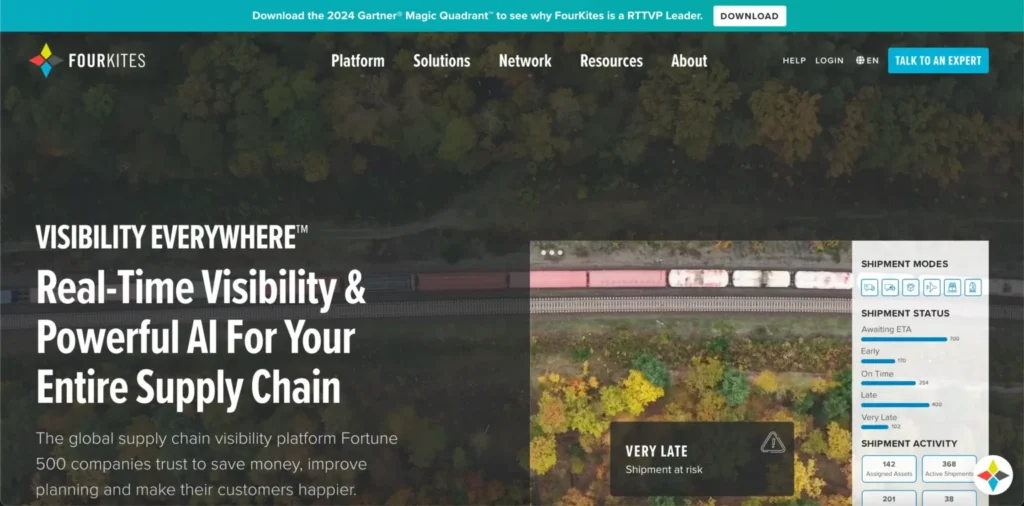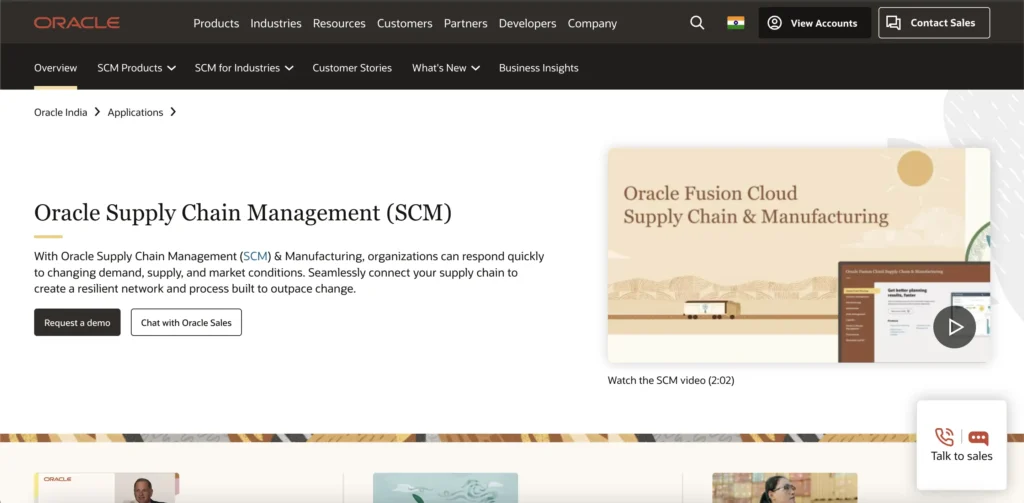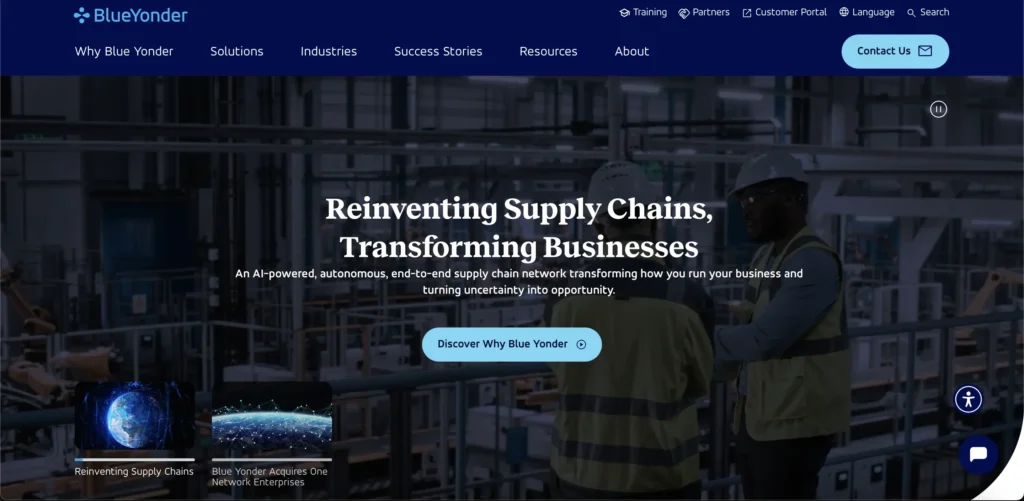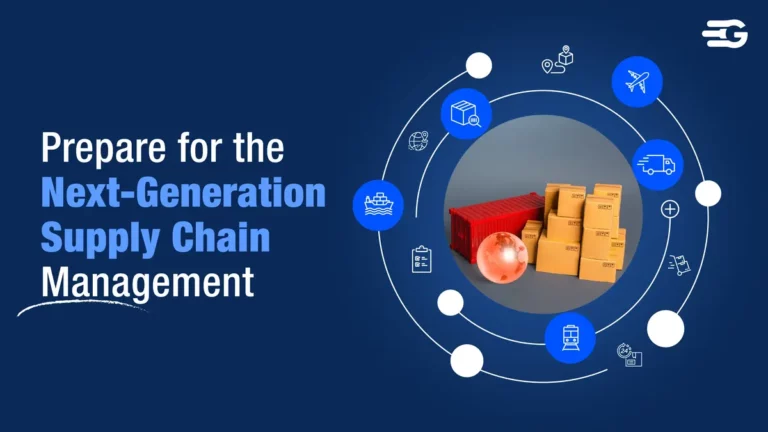Top 12 Supply Chain Management Software Tools for Efficiency
Supply chain management can make or break a business. Without the right tools, managing logistics, inventory, and supplier relationships becomes complex. However, with the proper supply chain management software, these processes flow smoothly. Here’s a detailed overview of 12 of the best supply chain management tools available for businesses today.
Criteria for Choosing the Best Supply Chain Management Software
When evaluating supply chain management tools, several key factors are crucial in determining their effectiveness. We focused on specific criteria to ensure these tools provide real value and help businesses optimize their supply chain processes. Here’s what we considered:
1. Ease of Use
A tool should have a user-friendly interface that simplifies complex supply chain tasks. We assessed how intuitive the software is and how easily new users can navigate it without extensive training. A tool that’s easy to use saves time and reduces operational challenges.
2. Scalability
As businesses grow, so do their supply chain needs. We evaluated whether each tool can scale to meet the demands of expanding businesses, both in terms of features and pricing. A scalable tool ensures businesses won’t outgrow the software as their operations expand.
3. Integration Capabilities
Supply chain management tools often need to integrate with existing systems like ERPs, CRMs, and accounting software. We examined how well each tool integrates with popular systems, as seamless integration helps prevent data silos and ensures smooth operations.
4. Real-time Visibility
Visibility into every part of the supply chain is essential for informed decision-making. We considered how well each tool offers real-time tracking and reporting features. Real-time visibility helps businesses respond quickly to disruptions or changes.
5. Customization
Every business has unique supply chain requirements. We reviewed how flexible and customizable each tool is to suit different business needs. The ability to adapt workflows, reports, and dashboards adds immense value, particularly for specialized industries.
However, it doesn’t end with customization we have compiled a resourceful checklist for you to download and keep handy during the process of purchasing a Supply Chain Management Software.

Essential Insight:
9 Factors to Elevate Supply Chain Management
By focusing on these criteria, we identified supply chain management software that not only performs well but also adds tangible value to businesses. Each tool was judged on these core areas to ensure it stands out as a reliable option for businesses looking to optimize their supply chain processes.
Best Supply Chain Management Software
| Software | Best for | Pros | Cons |
| GoComet | Businesses looking to optimize logistics and reduce shipping costs. | 1. Reduces shipping costs significantly 2. Offers real-time visibility of shipments 3. User-friendly interface | 1. Primarily focused on logistics 2. Limited features for smaller companies |
| Project44 | Companies seeking advanced shipment visibility and analytics capabilities. | 1. Provides detailed visibility into shipments 2. Offers powerful analytics tools 3. Scalability according to business needs | 1. Some users report a steep learning curve 2. Customer support may vary based on user experience |
| FourKites | Organizations looking for a user-friendly visibility solution. | Easy to use with a modern interface Strong analytics and reporting capabilities Efficient support with better stability | 1. Integration with existing systems can take time 2. Pricing may be on the higher end for smaller businesses |
| Oracle SCM Cloud | Large enterprises needing a full-featured solution. | 1. Scalable for businesses of all sizes 2. Extensive features for logistics and planning 3. Cloud access makes it easy to manage remotely | 1. Steep learning curve 2. High cost for smaller companies |
| Epicor SCM | Manufacturers who need precise demand forecasting. | 1. Helps reduce excess inventory 2. Strong integration with Epicor ERP 3. Ideal for manufacturers and distributors | 1. Implementation can take time 2. Expensive for small businesses |
| Blue Yonder | Retailers needing accurate demand forecasting and inventory management. | 1. AI-powered insights 2. Improves demand prediction accuracy 3. Strong support team | 1. Expensive for small companies 2. Needs skilled users |
| SAP SCM | Large businesses with complex supply chains. | 1. Comprehensive toolset 2. Integrates well with other SAP products 3. Real-time supply chain insights | 1. High cost, especially for small businesses 2. Requires extensive training |
| Kinaxis RapidResponse | Businesses that need fast, agile decision-making tools. | 1. Fast implementation 2. Real-time data helps with quick decision-making 3. Scalable for growing businesses | 1. May not be necessary for small companies 2. Complex initial setup |
| Logility | Companies looking to optimize inventory levels and demand planning. | 1. Improves demand forecasting 2. Easy to use 3. Helps reduce excess inventory | 1. Limited features outside inventory and demand 2. Higher costs for smaller businesses |
| Körber Supply Chain | Businesses with large warehouses and complex fulfillment processes. | 1. Excellent for optimizing large warehouses 2. Reduces labor costs through automation 3. Integrates with third-party systems | 1. Mainly focused on warehouse management 2. Can be expensive for smaller companies |
| E2open | Businesses with global operations needing real-time supply chain collaboration. | 1. Excellent for global supply chain collaboration 2. Cloud-based for easy access 3. Strong trade compliance tools | 1. Expensive for small to mid-sized businesses 2. Setup can take time |
| Shippabo | Small to mid-sized companies focused on freight management. | 1. User-friendly interface 2. Simplifies logistics management 3. Offers real-time shipment tracking | 1. Limited beyond logistics management 2. Not ideal for companies with complex supply chains |
1. GoComet
GoComet is a comprehensive AI-powered global supply chain platform that automates the entire supply chain, from procurement to delivery. It simplifies freight management by automating processes such as vendor price comparisons, helping companies secure the best shipping rates effortlessly. GoComet’s real-time tracking feature offers complete visibility, enabling businesses to monitor shipments at every stage, anticipate potential delays, and respond promptly.
Moreover, GoComet provides advanced analytics that pinpoint inefficiencies, helping businesses optimize routes, reduce costs, and streamline operations. For companies aiming to enhance their logistics and ensure smooth, end-to-end supply chain management, GoComet delivers unmatched efficiency.

Key Features:
- Streamlined Freight Procurement: Automates freight tender management and negotiation, saving time and ensuring competitive rates.
- Real-Time Shipment Updates: Tracks shipments at every stage with instant alerts on location, delays, and delivery times.
- Data-Driven Cost Optimization: Leverages advanced analytics to identify inefficiencies and minimize logistics expenses.
Limitations:
- Limited SKU-Level Tracking: The system may lack detailed tracking capabilities for individual stock-keeping units (SKUs), which can hinder granular inventory visibility.
Ratings and Reviews (as of Dec, 2024):
- G2 Rating: 4.8/5
- Gartner: 4.9/5
Testimonials:
“We have been using GoComet for a year and a half now and we love it. They offer unique features like Predictive ETA, bulk upload of trackings, real-time vessel tracking, Demurrage and Detention information, and much more. With all these features, the platform is still easy to use and understand. Their team is also very supportive and addresses any doubts we have efficiently and promptly.”
2. Project44
Project44 is an efficient supply chain visibility platform that focuses on real-time tracking and data sharing across the entire supply chain. Catering primarily to shippers and logistics service providers, it offers the tools necessary for effectively managing freight and optimizing operations.
With its extensive network of carriers and seamless integration with various systems, Project44 enhances logistics processes by providing complete visibility into shipments. The platform is designed to improve collaboration between all stakeholders in the supply chain, including suppliers, carriers, and customers.

Key Features:
- Comprehensive Real-Time Tracking: Delivers continuous shipment updates across various transportation modes, enabling precise monitoring and timely adjustments.
- Seamless System Integration: Easily connects with multiple transportation management systems (TMS), ensuring smooth data flow and eliminating silos.
- Actionable Predictive Analytics: Provides insights using advanced predictive models, empowering businesses to make proactive and informed supply chain decisions.
Limitations:
- Challenging Implementation Process: The setup process can be intricate, demanding significant time and dedicated resources.
- Higher Cost for Advanced Features: Offers premium functionality, which may not be cost-effective for businesses seeking basic visibility solutions.
- Data Quality Concerns: Occasional issues with inconsistent data and subpar technical support can impact reliability.
Reviews & Ratings (as of Dec, 2024):
- G2 Rating: 4.7/5
- Gartner: 4.7/5
Testimonials:
“The tool is easy to use and easy to implement. Great collaboration with our customer success manager. What stops me from giving an outstanding rating is frequent issues with data quality and a technical support that could be more effective.”
Maximize Efficiency:
60+ Questions for Choosing Supply Chain Tools
3. FourKites
FourKites offers real-time supply chain visibility that allows businesses to track shipments and inventory efficiently. It connects with multiple data sources to deliver comprehensive updates on delivery status, reducing uncertainty and enabling proactive management.
This platform focuses on transparency and collaboration, enhancing communication between suppliers, carriers, and customers. Its analytics capabilities also allow businesses to forecast supply chain issues and develop contingency plans to mitigate disruptions.

Key Features:
- Real-time time tracking: Real-time visibility across all modes of transportation, making it easier to track shipments.
- Predictive analysis: Machine learning-driven predictive analytics
- Better collaborations: Collaboration tools for better communication between stakeholders
- Easy Customization: Customizable dashboards and reporting tools
Limitations:
- Expert configuration: May require significant configuration to suit specific business needs
- Complex interface: Some users may find the interface overwhelming initially
Ratings and Reviews (as of Dec, 2024):
- G2 Rating: 4.8/5
- Gartner: 4.6/5
Testimonials:
‘We experienced quite a bit of turnover with our assigned project managers. In my opinion we cycled through them at a set cadence that was too fast. The implementation ran into significant friction with the carrier onboarding aspect. Connectivity has refined the process since.”
4. Oracle SCM Cloud
Oracle SCM Cloud is a comprehensive supply chain management suite that covers various areas, including inventory management, order fulfillment, and product lifecycle management. Its cloud-based structure allows for easy updates and access from anywhere, making it suitable for businesses of all sizes.
The platform excels in analytics and reporting, offering businesses actionable insights into their supply chain performance. With its strong integration capabilities, Oracle SCM Cloud can connect with other Oracle products and third-party applications, providing a streamlined experience.

Key Features:
- Comprehensive supply chain planning: Covers demand forecasting, inventory management, and production planning.
- Product lifecycle management: Tracks product development from inception to market.
- Cloud-based accessibility: Allows users to access the platform anytime, anywhere, with automatic updates.
Limitations:
- High implementation cost: Oracle’s extensive features come at a premium, making it less accessible for small businesses.
- Complex interface: The wide range of functionalities can make the platform overwhelming for new users.
- Long learning curve: It requires time and training for users to understand and fully utilize all the features.
Reviews & Ratings (as of Dec, 2024):
- G2 Rating: 4/5
- Gartner: 4.6/5
Testimonials:
“Positive final outcome, challenges to optimize the solution to work with our volumes and to access product expertise – overall, above average”
5. Epicor SCM
Epicor SCM offers a range of tools designed to streamline the supply chain process, from procurement to production and distribution. This platform is particularly well-suited for manufacturers, providing tailored solutions that meet industry-specific needs.
Epicor focuses on enhancing visibility and collaboration across the supply chain, allowing businesses to react quickly to changes in demand or supply. Its strong analytics capabilities enable companies to make informed decisions based on real-time data.

Key Features:
- Demand forecasting: Uses historical data and predictive analytics to estimate future demand.
- Inventory and supplier management: Helps manage stock levels and supplier relationships efficiently.
- Order tracking: Monitors order status from placement to delivery.
Limitations:
- Limited integration options: Does not integrate smoothly with all third-party tools.
- Expensive upgrades: Updates and customizations can add significant costs over time.
- Challenging implementation: Implementation may take time, especially for businesses with existing systems.
Reviews & Ratings (as of Dec, 2024):
- G2 Rating: N/A
- Gartner Rating: 4.2/5
Testimonials:
“I feel like Epicor is growing and becoming better suited to the needs of the user.”
6. Blue Yonder
Blue Yonder specializes in supply chain planning and execution, providing businesses with powerful tools for demand forecasting, inventory management, and logistics optimization. Its machine-learning capabilities help companies adapt to changing market conditions and enhance decision-making.
The platform is highly regarded for its predictive analytics, which assists businesses in anticipating supply chain disruptions and mitigating risks. Blue Yonder’s user-friendly interface simplifies complex tasks, allowing teams to focus on strategy rather than manual processes.

Key Features:
- AI-driven demand forecasting: Uses artificial intelligence to predict demand more accurately.
- Real-time inventory and order management: Monitors inventory levels and orders to prevent stockouts or overstocking.
- Supply chain analytics: Provides insights to optimize supply chain processes.
Limitations:
- Complexity in setup: Initial setup can be challenging, especially for businesses unfamiliar with AI-driven solutions.
- High cost: Advanced AI functionalities come with a high price tag, which might not suit smaller businesses.
- Support limitations: Customer support may take time to resolve issues due to the complexity of the platform.
Reviews & Ratings (as of Dec, 2024):
- G2 Rating: 4.1/5
- Gartner Rating: 4.1/5
Testimonials:
“The Blue Yonder software functions as documented. They do listen but have become less responsive to problems as they are discovered.”

7. SAP SCM
SAP SCM provides a suite of integrated applications for managing supply chain processes. It offers tools for demand planning, supply network planning, and logistics execution, making it a versatile choice for various industries.
The platform excels in data integration, enabling real-time information sharing across departments and locations. Its analytics features provide insights into performance metrics, helping businesses optimize their operations continuously.

Key Features:
- Advanced supply chain planning: Enables precise planning of production, distribution, and logistics.
- Logistics and manufacturing management: Integrates manufacturing and distribution processes.
- Real-time analytics: Delivers data for quick decision-making on supply chain operations.
Limitations:
- Expensive: SAP is known for its premium pricing, which may be prohibitive for smaller enterprises.
- Difficult implementation: Setup and integration can be complex and time-consuming.
- High customization costs: Customizing the system to meet unique business requirements can be costly.
Reviews & Ratings (as of Dec, 2024):
- G2 Rating: 4.1/5
- Gartner Rating: 4.2/5
Testimonials:
“My overall experience with SAP was good as I can easily get things planned through analytics provided by the supply that generates demand for the product as a result business achieves efficiency on real time basis.”
8. Kinaxis RapidResponse
Kinaxis RapidResponse focuses on supply chain planning and response management. Its platform allows businesses to react quickly to changes, making it ideal for companies in fast-paced industries.
With its ability to simulate different scenarios, RapidResponse helps businesses prepare for potential disruptions. The platform’s collaborative capabilities enable teams to work together effectively, enhancing overall supply chain efficiency.

Key Features:
- Real-time supply chain visibility: Offers a comprehensive view of supply chain activities as they happen.
- Scenario planning: Helps businesses simulate different supply chain scenarios to make better decisions.
- Supply and demand balancing: Ensures optimal stock levels by synchronizing supply and demand.
Limitations:
- High cost: Suitable for larger enterprises with bigger budgets; may not be affordable for smaller businesses.
- Limited third-party integrations: While powerful on its own, integration with certain third-party tools can be challenging.
- Steep learning curve: The tool requires significant training to fully utilize all features.
Reviews & Ratings (as of Dec, 2024):
- G2 Rating: 4.0/5
- Gartner Rating: 4.6/5
Testimonials:
“The software has all the features of an online tool with aggregations and reporting at all levels. However, the core of the tool should be the statistical forecasting that the software fails at miserably.”
9. Logility
Logility is a supply chain management tool that focuses on demand planning, inventory management, and transportation planning. Its advanced algorithms help businesses forecast demand with precision. This, in turn, leads to better inventory management and reduces the chances of overstock or stockouts.
Logility also offers strong collaboration tools, allowing different departments to work together seamlessly. This software ensures that businesses can respond quickly to market changes and meet customer demand without delays.

Key Features:
- Inventory and demand optimization: Aligns stock levels with current and projected demand.
- Supplier collaboration tools: Facilitates communication and coordination with suppliers.
- Automated order fulfillment: Streamlines the process from receiving orders to delivery.
Limitations:
- Outdated interface: Some users may find the interface less modern compared to newer platforms.
- Costly for small businesses: Pricing may not be ideal for smaller companies with limited resources.
- Long implementation times: Implementing and fully integrating Logility can take considerable time.
Ratings Reviews (as of Dec, 2024):
- G2 Rating: 4.2/5
- Gartner Rating: 4.6/5
Testimonials:
“Very solid experience using Logility. We’re using the software to Forecast our sales and replenishment. Product can run slowly at times and hard to understand some of the commands, but the interface is easy to see.”
10. Körber Supply Chain
Körber Supply Chain offers a range of solutions that cover warehouse management, transportation management, and supply chain execution. Its warehouse management system is one of the most advanced in the market, allowing businesses to optimize their storage and distribution processes.
One of the key benefits of Körber is its scalability. It’s suitable for both small businesses and large enterprises, as it can easily adapt to a company’s growing needs. Körber also integrates well with other enterprise systems, ensuring that companies can have a unified approach to managing their supply chains.

Key Features:
- Warehouse management: Optimizes space, inventory flow, and stock accuracy within warehouses.
- Labor management: Helps allocate labor resources efficiently based on demand.
- Order fulfillment automation: Automates picking, packing, and shipping to reduce errors.
Limitations:
- Limited industry focus: Best suited for warehouse operations; not as versatile for broader supply chain needs.
- Expensive for small companies: Pricing may be prohibitive for smaller businesses with less complex supply chain operations.
- Slow response from support: Some users report slow customer support response times for technical issues.
Reviews & Ratings (as of Dec, 2024):
- G2 Rating: N/A
- Gartner Rating: 4.5/5
Testimonials:
“Like the general direction things are headed. The voice connector, automation options, and future state of WMS are all cool. Wish there were more technical insight on some products.”
11. E2open
E2open provides a comprehensive supply chain management platform that focuses on visibility and collaboration. Its tools help businesses manage inventory, logistics, and supplier relationships effectively.
The platform stands out for its ability to integrate data from various sources, allowing businesses to gain a complete view of their supply chain. E2open’s analytics capabilities support data-driven decision-making and improve overall operational efficiency.

Key Features:
- Collaborative planning: Enables real-time collaboration between manufacturers, suppliers, and partners.
- Supply chain execution: Automates tasks like procurement, production, and logistics management.
- Global trade management: Handles the complexities of cross-border trade and compliance.
Limitations:
- High cost: Pricing can be high, particularly for smaller businesses or startups.
- Complex interface: The platform’s breadth of features can overwhelm users unfamiliar with complex systems.
- Slow updates: Users have reported that system updates or bug fixes can take longer than expected.
Reviews Ratings (as of Dec, 2024):
- G2 Rating: 4.1/5
- Gartner Rating: 4.6/5
Testimonials:
“Like the general direction things are headed. The voice connector, automation options, and future state of WMS are all cool. Wish there were more technical insight on some products.”
12. Shippabo
Shippabo focuses on streamlining the shipping process for businesses engaged in international trade. Its platform offers tools for managing logistics, inventory, and supply chain visibility.
With its user-friendly interface and focus on collaboration, Shippabo enhances communication between suppliers, carriers, and customers. The platform also provides real-time tracking, which allows businesses to monitor shipments closely.

Key Features:
- Freight booking and management: Simplifies booking of freight with various carriers.
- Real-time shipment tracking: Tracks shipments from dispatch to delivery with up-to-date statuses.
- Automated shipping documents: Automatically generates and organizes shipping documents.
Limitations:
- Limited advanced features: Shippabo is more basic compared to competitors, lacking some of the advanced functionalities larger businesses may require.
- No mobile app: The lack of a mobile app can be limiting for users who need to access the system on the go.
- Limited carrier integration: Carrier options may be limited depending on the region or shipping lanes used.
Reviews & Ratings (as of Dec, 2024):
- G2 Rating: 4.8/5
- Gartner Rating: N/A
Testimonials:
“UI is pretty decent, have a hard time explaining the know how’s to more elderly colleagues but especially for certain tasks I can just show them how and they are able to grasp it. Some glitches once in a while, when working and have multiple projects open it takes an extra second to load, I’m pretty sure the internet is stable hence must be the tool.”
Wrapping Up
Choosing the right supply chain management tool is crucial for optimizing operations and improving efficiency. Each of the tools listed here offers unique features and benefits that cater to different business needs. By carefully evaluating your specific requirements and considering the key factors outlined, you can select a solution that will support your supply chain management goals and drive your business forward.






